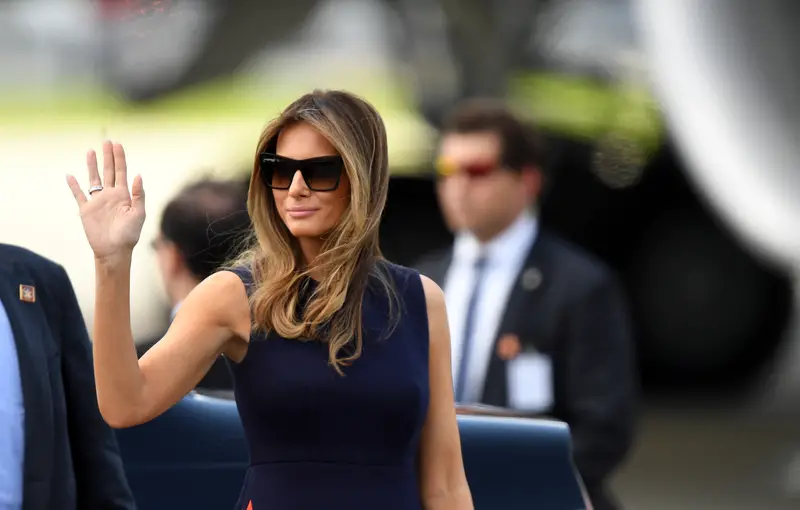Ever wonder how much those stunning First Lady outfits actually cost? While we admire their polished looks at state dinners and official events, the price tags behind these carefully chosen ensembles often reach amounts that could buy a luxury car. From custom designer gowns to everyday accessories, First Ladies throughout history have worn pieces that cost more than most people’s annual salaries, sparking debates about fashion spending and public image.
Michelle Obama’s state dinner gowns cost thousands
Michelle Obama became known for mixing high-end designer pieces with more affordable options, but her formal state dinner looks often carried price tags exceeding $10,000. Her custom Jason Wu gown for the 2009 Inaugural Ball reportedly cost around $8,500, while other designer pieces for official events ranged from $2,000 to $15,000 each.
The former First Lady’s approach to fashion included strategic choices that balanced luxury with accessibility. She often wore pieces from emerging American designers, giving them international exposure while supporting domestic fashion industry. Her evening gowns for state functions were custom-made, requiring multiple fittings and alterations that added to the overall cost. Each piece was selected months in advance, with teams of stylists ensuring every detail aligned with diplomatic protocols and cultural sensitivities.
Melania Trump’s coat collection reached six figures
Melania Trump’s fashion choices often made headlines for their astronomical costs, with single coats sometimes exceeding $50,000. Her Dolce & Gabbana coat worn during a 2017 trip to Sicily cost approximately $51,000, while a simple white coat by The Row carried a $4,000 price tag. These weren’t one-time splurges – her entire wardrobe collection was estimated to be worth several million dollars, featuring pieces from luxury European fashion houses and exclusive American designers.
The most talked-about piece was probably her $2,000 Balmain shirt worn during Hurricane Harvey relief efforts, which critics said seemed tone-deaf given the circumstances. Her collection included numerous designer coats from brands like Chanel, Dior, and custom pieces that required international shipping and fitting appointments. Each outfit was carefully documented by fashion photographers, creating a visual record of some of the most expensive clothing ever worn by a sitting First Lady.
Jackie Kennedy’s pink suit became priceless history
Jacqueline Kennedy’s famous pink Chanel suit, worn on the day President Kennedy was assassinated, was originally valued at around $1,000 in 1963 dollars – equivalent to about $8,500 today. However, this piece transcended monetary value to become one of the most significant fashion artifacts in American history. The suit, still stained with blood, is now housed in the National Archives and considered priceless due to its historical importance and emotional significance.
Beyond that tragic day, Jackie Kennedy’s fashion choices consistently featured expensive European designs that influenced American style for decades. Her wardrobe included custom pieces from Oleg Cassini, who became her exclusive designer, creating looks that cost between $500 to $2,000 per piece in 1960s prices. These designer suits and gowns were meticulously crafted with the finest fabrics and attention to detail that established the template for presidential fashion. Her influence on American fashion was so profound that many of her looks are still referenced by designers today.
Nancy Reagan’s borrowed gowns avoided public criticism
Nancy Reagan developed a system of borrowing designer gowns to avoid criticism about spending taxpayer money on clothes, but the actual value of these borrowed pieces often exceeded $10,000 each. Designers like James Galanos and Bill Blass would loan her custom creations for state dinners and official events, with the understanding that the exposure was worth more than the retail price. This arrangement allowed her to wear incredibly expensive pieces while technically not purchasing them with public funds.
The borrowed gowns included intricate beadwork, imported fabrics, and custom embellishments that took months to complete. One Galanos gown worn to a 1985 state dinner was valued at $25,000, featuring hand-sewn crystals and silk imported from France. These formal gowns required special handling, insurance, and storage, creating hidden costs beyond their initial price tags. The system worked so well that many subsequent First Ladies adopted similar borrowing arrangements with high-end designers, creating a tradition of expensive fashion without direct purchase.
Hillary Clinton’s pantsuits sparked fashion debates
Hillary Clinton’s signature pantsuits became a political statement as much as a fashion choice, with individual pieces often costing between $2,000 to $5,000 from designers like Ralph Lauren and Oscar de la Renta. Her decision to wear pantsuits exclusively for most official events was groundbreaking for First Ladies, but the custom tailoring and premium fabrics kept the costs high despite the relatively simple designs. Each suit required multiple fittings and alterations to achieve the perfect fit for television appearances and public events.
The pantsuit collection grew to include dozens of different colors and styles, with some featuring subtle details like custom buttons or unique fabric blends that weren’t available to regular consumers. Her designers created pieces specifically for different occasions – lighter fabrics for outdoor events, wrinkle-resistant materials for travel, and more formal options for evening functions. These business suits became so iconic that they influenced professional women’s fashion across the country, proving that expensive political fashion could have lasting cultural impact beyond the White House years.
Barbara Bush chose pearls over expensive gowns
Barbara Bush deliberately chose a more modest approach to First Lady fashion, but her signature three-strand pearl necklace was valued at over $25,000 and became her most expensive fashion statement. She often wore off-the-rack dresses and suits that cost between $200 to $800, making her one of the most budget-conscious First Ladies in recent history. However, her pearl collection included several sets worth thousands of dollars each, proving that even understated elegance could carry significant price tags.
Her approach resonated with many Americans who appreciated seeing a First Lady who didn’t constantly wear designer labels or custom creations. The pearls became so associated with her image that she rarely appeared in public without them, creating a consistent and recognizable style that didn’t require constant wardrobe updates. Her pearl necklaces were often family heirlooms or gifts from foreign dignitaries, adding sentimental value beyond their monetary worth. This strategy proved that effective First Lady fashion didn’t always require the highest price tags, though quality pieces still commanded premium prices.
Laura Bush mixed designer pieces with mall brands
Laura Bush developed a reputation for mixing expensive designer pieces with more affordable options from mainstream retailers, creating looks that ranged from $300 department store dresses to $8,000 custom gowns. Her inaugural ball gown by Michael Faircloth cost approximately $8,500, while many of her everyday outfits featured pieces from stores like Ann Taylor and Talbot’s that cost under $500. This approach made her fashion choices more relatable while still maintaining the elegance expected of a First Lady.
Her strategy included investing in quality accessories and shoes that could elevate less expensive clothing, proving that smart shopping could achieve expensive-looking results on a more reasonable budget. She often repeated favorite pieces, wearing the same dress or suit to multiple events with different accessories to create new looks. Her classic dresses and conservative styling choices reflected her background as a librarian and teacher, showing that First Lady fashion could honor traditional American values while still incorporating luxury elements when appropriate for state functions.
Jill Biden promotes American designers affordably
Jill Biden has made supporting American designers a priority while keeping costs more reasonable than previous First Ladies, with most pieces ranging from $1,000 to $3,000 rather than the five-figure price tags of some predecessors. Her inaugural outfits featured emerging American designers like Markarian and Brandon Maxwell, giving smaller fashion houses international exposure while maintaining elegant styling appropriate for official events. This approach balances supporting the domestic fashion industry with more moderate spending that’s less likely to generate negative publicity.
Her fashion choices often include symbolic elements like colors that honor specific causes or American-made accessories that highlight domestic manufacturing. She frequently rewears pieces and mixes new items with existing wardrobe staples, creating a more sustainable approach to official dressing that resonates with current fashion trends. Her American-made clothing choices demonstrate how First Lady fashion can support political and economic goals while still maintaining the visual impact expected for international appearances and state functions.
State dinner dress codes require expensive pieces
Protocol for state dinners and official international visits often requires First Ladies to wear formal gowns that cost between $5,000 to $20,000, as these events demand the highest level of elegance to represent American sophistication to world leaders. The expectation for unique, never-before-worn pieces means each major international event requires a new custom creation, making the annual wardrobe budget for formal events alone reach six figures. These aren’t just clothes – they’re diplomatic tools designed to convey respect, power, and cultural awareness.
The requirements extend beyond just the dress to include coordinating shoes, jewelry, and accessories that meet security protocols while maintaining the overall aesthetic vision. Many pieces require special alterations for concealed security equipment, adding to the cost and complexity of each outfit. The formal evening wear must photograph well under various lighting conditions and look appropriate when seated at state dinners or standing for official photos. Each piece becomes part of historical record, making the investment in quality and timeless design essential for representing the country’s image for future generations.
The shocking price tags behind First Lady fashion reflect the unique demands of representing America on the world stage, where clothing becomes diplomacy and personal style carries national significance. While these costs might seem excessive for everyday wardrobes, they represent investments in America’s image that extend far beyond simple clothing purchases. The next time someone questions why First Lady fashion costs so much, remember that these pieces serve as diplomatic tools, historical artifacts, and symbols of American style that influence fashion trends for decades to come.

